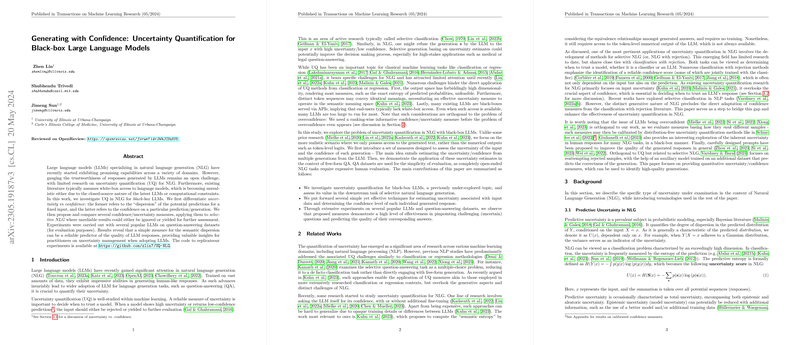Generating with Confidence: Uncertainty Quantification for Black-box LLMs
The paper "Generating with Confidence: Uncertainty Quantification for Black-box LLMs" addresses the pressing issue of uncertainty quantification (UQ) in the context of LLMs used for natural language generation (NLG), particularly under black-box scenarios. The core concern of the research is to develop and evaluate methodologies that accurately measure the uncertainty associated with the outputs of LLMs, especially when these models are accessible only via API calls and without internal access to the model's weights, biases, or logits.
Key Concepts and Methodologies
- Uncertainty vs Confidence: The paper delineates the concepts of uncertainty and confidence in the domain of LLMs. Uncertainty is depicted as the overall dispersion of potential outputs for a given input, whereas confidence pertains to the certainty of a specific model output being correct. This distinction is crucial for improving the reliability of AI systems in practical applications.
- Uncertainty Measures Developed:
- Semantic Dispersion: The paper proposes a metric based on semantic similarity across multiple outputs from the model. This is calculated using techniques like Jaccard Similarity and Natural Language Inference (NLI) models to determine the semantic distance or alignment between outputs.
- Graph-based Spectral Methods: The researchers introduce the use of eigenvalues from graph Laplacians constructed from response similarity matrices as indications of uncertainty, leveraging spectral clustering methodologies.
- Confidence Measures:
- Pairwise Comparison using NLI: Confidence is extracted by leveraging entailment and contradiction scores between the generated responses, aiming to assess how reliably a specific output aligns with likely truths or expected answers.
- Embedding-based Metrics: Techniques such as Eccentricity and Degree Matrix are used to establish confidence based on the distribution of response embeddings in a lower-dimensional space.
Experimental Framework
The research builds an experimental setup using several QA datasets such as CoQA, TriviaQA, and Natural Questions to test LLMs including OpenAI's GPT-3.5, LLaMA, and OPT. These datasets provide a controlled environment to assess the models’ performance under the developed uncertainty and confidence measures.
Results Summary
- Uncertainty Evaluation: The results demonstrate that the proposed uncertainty measures, specifically those utilizing semantic dispersion and spectral clustering methods, show significant promise in effectively predicting the variance in output quality. These measures were notably robust even when compared against traditional white-box methods which require internal model logits for estimation.
- Confidence Prediction: The confidence measures effectively improved task performance by allowing the system to selectively reject outputs that were predicted to be incorrect, thereby enhancing overall reliability without significant loss of coverage.
Implications and Future Perspectives
The practical implications of these findings are substantial. In high-stakes environments like legal or medical domains, being able to gauge the uncertainty of an LLM's output is critical for system reliability. Moreover, in cases where access to internal model parameters is restricted due to proprietary or computational constraints, these black-box methods provide a valuable framework.
Theoretically, this paper also sets a foundation for further exploration into the integration of uncertainty and confidence methods with broader AI applications, potentially contributing to the development of more autonomous decision-making technologies that ask for human intervention only when necessary.
Conclusion
The paper effectively introduces novel and computationally feasible methods to quantify uncertainty in LLMs operating as black-box systems. The proposed methodologies align closely with the practical needs of deploying LLMs in real-world applications, opening pathways for future research and implementation strategies that can accommodate the ongoing trend of increasingly large and often proprietary AI models.
